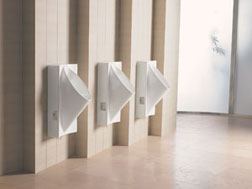Water Conservation Is Key In EPA's WaterSense Program
 EPA has certified 35 toilets.
|
First it was electricity, now it’s water. Taking a cue from its Energy Star program, the Environmental Protection Agency now is implementing the WaterSense water-conservation program to identify and certify products such as toilets, faucets, showerheads and irrigation equipment based on their water-conserving performance. EPA estimates that use of WaterSense products could save 128 billion gallons of water per year in the U.S., enough to supply 3.5 million people.
Announced last summer, the program currently lists high-efficiency toilets (HETs) certified by EPA, which reduce water use by at least 20%, as compared to traditional toilets. EPA will begin certifying showerheads and faucets in 2008. It currently is developing specifications for those products through a steering committee made up of manufacturers, industry associations, environmental conservation organizations and other water professionals, says EPA spokeswoman Enesta Jones. Testing for certification is done through a third-party, independent lab.
 Touchless faucets are gaining ground. |
The program also lists WaterSense-certified irrigation professionals who install or maintain irrigation systems.
Manufacturers voluntarily join the program and submit products for certification. So far, WaterSense has certified 35 HETs from six manufacturers: American Standard, Caroma, Kohler, Niagara, TOTO and Vitra.
WaterSense certifications are applicable to single- and dual-flush tank-type gravity toilets, pressure-assist toilets, electro-hydraulic toilets and other technologies that meet WaterSense performance specifications. To meet these specs, toilets must use no more than 1.28 gallons of water per flush, effectively remove at least 350 grams of waste and not be adjustable to exceed more than 1.68 gallons of water per flush.
 Touchless faucets are gaining ground.
|
Manufacturers say that as technology has improved performance, the demand for HETs has risen sharply in recent years in both residential and commercial buildings. In fact, manufacturers are investing in new HET models and technology at a pace that suggests traditional toilets’ days are numbered. Many point to ongoing water shortages in 36 states, and a pending legislative bill in California that would mandate use of HETs in all new construction in the state.
 EPA will develop specs and begin certifying urinals in 2008. |
Gov. Arnold Schwarzenegger (R) vetoed a similar bill last year, but if the the California law is enacted, it will be a harbinger of things to come, manufacturers say. “There are more and more builders and architects seeking points for green certifications on building designs. It’s just a matter of time before legislation comes,” says Mert Karasu, technical manager for Vitra USA in Atlanta.
A participant in WaterSense’s steering committee, Karasu expects specifications for urinals to be announced next year, and that the specs probably will require urinals to use a quart of water per flush, rather than the traditional one-gallon flush.
A participant in WaterSense’s steering committee, Karasu expects specifications for urinals to be announced next year, and that the specs probably will require urinals to use a quart of water per flush, rather than the traditional one-gallon flush.
For more information and a list of certified products and professionals visit http://www.epa.gov/watersense.

Post a comment to this article
Report Abusive Comment